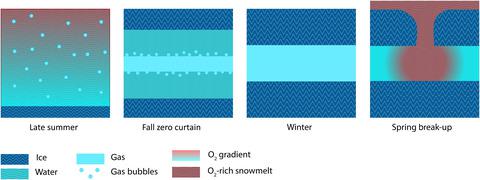当前位置:
X-MOL 学术
›
Glob. Change Biol.
›
论文详情
Our official English website, www.x-mol.net, welcomes your feedback! (Note: you will need to create a separate account there.)
Snow melt stimulates ecosystem respiration in Arctic ecosystems.
Global Change Biology ( IF 11.6 ) Pub Date : 2020-06-30 , DOI: 10.1111/gcb.15193 Kyle A Arndt 1, 2 , David A Lipson 1 , Josh Hashemi 1, 2 , Walter C Oechel 1, 3 , Donatella Zona 1, 4
Global Change Biology ( IF 11.6 ) Pub Date : 2020-06-30 , DOI: 10.1111/gcb.15193 Kyle A Arndt 1, 2 , David A Lipson 1 , Josh Hashemi 1, 2 , Walter C Oechel 1, 3 , Donatella Zona 1, 4
Affiliation

|
Cold seasons in Arctic ecosystems are increasingly important to the annual carbon balance of these vulnerable ecosystems. Arctic winters are largely harsh and inaccessible leading historic data gaps during that time. Until recently, cold seasons have been assumed to have negligible impacts on the annual carbon balance but as data coverage increases and the Arctic warms, the cold season has been shown to account for over half of annual methane (CH4) emissions and can offset summer photosynthetic carbon dioxide (CO2) uptake. Freeze–thaw cycle dynamics play a critical role in controlling cold season CO2 and CH4 loss, but the relationship has not been extensively studied. Here, we analyze freeze–thaw processes through in situ CO2 and CH4 fluxes in conjunction with soil cores for physical structure and porewater samples for redox biogeochemistry. We find a movement of water toward freezing fronts in soil cores, leaving air spaces in soils, which allows for rapid infiltration of oxygen‐rich snow melt in spring as shown by oxidized iron in porewater. The snow melt period coincides with rising ecosystem respiration and can offset up to 41% of the summer CO2 uptake. Our study highlights this important seasonal process and shows spring greenhouse gas emissions are largely due to production from respiration instead of only bursts of stored gases. Further warming is projected to result in increases of snowpack and deeper thaws, which could increase this ecosystem respiration dominate snow melt period causing larger greenhouse gas losses during spring.
中文翻译:

融雪会刺激北极生态系统中的生态系统呼吸。
北极生态系统的寒冷季节对于这些脆弱的生态系统的年度碳平衡越来越重要。在此期间,北极冬季极为严峻且无法访问,从而导致历史数据空白。直到最近,人们都认为寒冷季节对年度碳平衡的影响可以忽略不计,但是随着数据覆盖率的增加和北极变暖,寒冷季节已被证明占每年甲烷(CH 4)排放量的一半以上,并可以抵消夏季光合二氧化碳(CO 2)吸收。冻融循环动力学在控制寒冷季节CO 2和CH 4的损失中起着关键作用,但是这种关系尚未得到广泛研究。在这里,我们通过原位CO分析了冻融过程2和CH 4通量与土壤芯一起用于物理结构,而孔隙水样品则用于氧化还原生物地球化学。我们发现水向着土壤核心的冰冻前沿运动,在土壤中留下了空气空间,这使得春季富氧的雪融迅速渗透,如孔隙水中的氧化铁所示。融雪期与生态系统呼吸上升同时发生,可以抵消夏季CO 2的41%摄取。我们的研究强调了这一重要的季节性过程,并显示春季温室气体排放主要是由于呼吸作用产生的,而不是储存气体的爆发。预计进一步的变暖将导致积雪的增加和融雪的加深,这可能会增加这种生态系统的呼吸作用,在融雪期间占主导地位,从而导致春季温室气体的损失更大。
更新日期:2020-08-11
中文翻译:

融雪会刺激北极生态系统中的生态系统呼吸。
北极生态系统的寒冷季节对于这些脆弱的生态系统的年度碳平衡越来越重要。在此期间,北极冬季极为严峻且无法访问,从而导致历史数据空白。直到最近,人们都认为寒冷季节对年度碳平衡的影响可以忽略不计,但是随着数据覆盖率的增加和北极变暖,寒冷季节已被证明占每年甲烷(CH 4)排放量的一半以上,并可以抵消夏季光合二氧化碳(CO 2)吸收。冻融循环动力学在控制寒冷季节CO 2和CH 4的损失中起着关键作用,但是这种关系尚未得到广泛研究。在这里,我们通过原位CO分析了冻融过程2和CH 4通量与土壤芯一起用于物理结构,而孔隙水样品则用于氧化还原生物地球化学。我们发现水向着土壤核心的冰冻前沿运动,在土壤中留下了空气空间,这使得春季富氧的雪融迅速渗透,如孔隙水中的氧化铁所示。融雪期与生态系统呼吸上升同时发生,可以抵消夏季CO 2的41%摄取。我们的研究强调了这一重要的季节性过程,并显示春季温室气体排放主要是由于呼吸作用产生的,而不是储存气体的爆发。预计进一步的变暖将导致积雪的增加和融雪的加深,这可能会增加这种生态系统的呼吸作用,在融雪期间占主导地位,从而导致春季温室气体的损失更大。


























 京公网安备 11010802027423号
京公网安备 11010802027423号